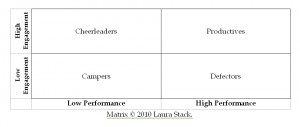“Since my last report, he has reached rock bottom and has started to dig.” — Anonymous report from an employee evaluation (possibly apocryphal)
“American business long ago gave up on demanding that prospective employees be honest and hardworking. It has even stopped hoping for employees who are educated enough that they can tell the difference between the men’s room and the women’s room without having little pictures on the doors.” — Dave Barry, humorist
In September’s newsletter, I introduced you to a new idea: the concept of group productivity management, based on the six Productivity Keys I outlined in my most recent book, SuperCompetent.
Now, I created SuperCompetent for those individuals who want to raise their personal productivity to the maximum possible level; so as written, it doesn’t really apply to group management. But not long after John Wiley and Sons released SuperCompetent, a client asked me how it all applied to managing people…and I thought that was a very good question. After a little thought, I came up with this matrix, which compares competence with employee engagement—one of the most important concepts going around management circles these days.
The Productivity Management Matrix is a quick, simple way of categorizing team members so you that can recognize the SuperCompetents and the not-so-competents at a glance. In the four blog entries I’ll post this month, I’ll cover all four quadrants: Campers, Cheerleaders, Defectors, and Productives.
Let’s start with the lowest of the low: the dreaded Campers, who combine low performance with low engagement to come up with a sum that’s far less than the whole.
How to Spot a Camper
I call disengaged low performers “Campers” because that’s what they do: they camp in a chair and huddle in place, waiting for it to be all over. They could care less about fellow employees, the company in general, or the people they’re supposed to be serving.
If you’ve ever seen the character of Wally in the comic strip Dilbert, you’ve seen the classic Camper in action…if you can call it that. All he ever does is walk around with his coffee mug. That’s typical; Campers do as little work as possible to get by. Often, they’re actively disengaged from the company rather than merely unengaged, which means that even when they’re not really trying to, Campers are sabotaging your organization.
One quick caveat: be careful about who you classify as a Camper, because in many cases, brand new employees may seem to combine low engagement with low performance the way that Campers do. But that’s acceptable, because they’re still learning their jobs. They simply don’t know the ropes well enough yet to be high-performing, and aren’t familiar enough with the company to be highly engaged. Give new people a little time to prove where they fit into the Matrix before you assume they’re Campers.
How a Camper Can Impact Your Team
A Camper can be death to your organization. The analogies are endless: they’re the bad apple that spoils the bunch, the anchor that drags you down, the virus that ruins a well-functioning organism. Campers act as bottlenecks in workflow, because they’ll get their work done when they darn well please. They depress other people, and can infect them with their apathy, souring otherwise good employees and lowering their levels of engagement. Oh, they may not deliberately hurt your organization—but they really don’t care if they do or not. All they care about is drawing a paycheck and making it to five o’clock, to Friday, to the end of the year…and finally to retirement.
How to Handle a Camper
You can’t just ignore a Camper, or they’ll ruin you. Personally, I’d recommend that you fire them if you can. Oh, give them a chance to clean up their act first; they may surprise you by becoming a more engaged, competent employee (sometimes people just need a little push-start). But don’t be surprised if your unhappy Camper figuratively (or even literally) shoots you the bird when you tell them to shape up or ship out. If that happens, your decision is obvious.
How to Coach the Camper
When trying to counsel a Camper, you have to keep one thing in mind: subtlety is wasted on them. Be blunt: approach them and tell them you’re going to let them go if they don’t start turning things around. Lay out your corrective action plan point by point, and make absolutely sure they understand and sign off on everything. Set mileposts and check to see if they’re meeting them. This is one of those rare cases where micromanagement may be necessary.
A month should be long enough to turn things around. If there’s noticeable change, great! If not, then you’ll have to do what’s best for the team and the company.
In Conclusion…Campers have to be dealt with immediately and with finality, one way or another, or they’ll drag everyone else down to their level.
If you just can’t change the Camper and you have no say in terminating them, you can’t just sit there chewing on your frustration. There are ways that you can isolate them from the rest of your organization. Don’t give them anything important to do, and keep them away from your other team members if at all possible. After all, quarantine is a tried-and-true method of protecting the uninfected from a disease.




[…] organization has its “Campers” — uninspired workers who hunker down and do only what they have to, waiting for the weekend to come, and eventually, […]